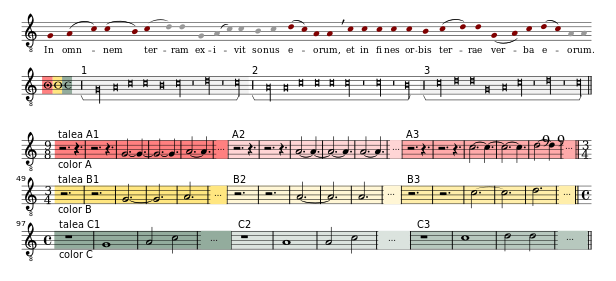Sub Arturo (In omnem terram) isorhythmic tenor
Autor:
Přisuzování:
Obrázek je označen jako „Vyžadováno uvedení zdroje“ (Attribution Required), ale nebyly uvedeny žádné informace o přiřazení. Při použití šablony MediaWiki pro licence CC-BY byl pravděpodobně parametr atribuce vynechán. Autoři zde mohou najít příklad pro správné použití šablon.
Shortlink:
Zdroj:
Formát:
616 x 281 Pixel (700262 Bytes)
Popis:
Structural diagram of the isorhythmic tenor of a late 14th century motet of the Ars Nova, "Sub arturo plebs – fons citharizantium – in omnem terram", by John Aleyn (Alanus), featuring threefold isorhythmic diminution.
- First staff: preexisting Gregorian cantus firmus melody, from the first antiphon for the first nocturn of the commons for Apostles, "In omnem terram exivit sonus eorum" ('their voice has gone out into all the world'). Melody transposed one fifth up; notes used for the tenor marked in red.
- Second staff: Isorhythmic tenor as notated in mensural notation. Numbers 1-3 and brackets indicate three rhythmically identical sequences (taleae). The three mensuration signs in the beginning define the pattern of diminution, indicating "tempus perfectum cum prolatione maiore, tempus imperfectum cum prolatione minore and tempus imperfectum cum prolatione minore, respectively. (In the manuscript these signs are in fact found at the end of the line, together with a repetition sign.)
- Staves 2-5: Abbreviated transcription into modern notation. Each line represents one full repetition of the tenor (color), including the three talea in each, resulting in a nine-part structure. (Within each color, only the first few notes of each talea are rendered here.) The three mensuration signs in the line above correspond to the change in time signatures (9/8, 3/4, 2/4). In each color, the duration of each note is shortened by a factor of 2/3.
Licence:
Credit:
Vlastní dílo
Relevantní články
Izorytmické motetoIzorytmické moteto je forma vrcholného moteta a jeho racionální strukturalizace v období gotické hudby. .. pokračovat ve čtení
IzorytmieIzorytmie, dříve isor(h)ytmie, isorytmika apod., je jeden principů utváření motet ve 14. a 15. století. Nejčastější formou psanou izorytmickou technikou bylo moteto. .. pokračovat ve čtení
